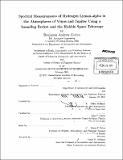| dc.contributor.advisor | Jeffrey Hoffman and John T. Clarke. | en_US |
| dc.contributor.author | Corbin, Benjamin Andrew | en_US |
| dc.contributor.other | Massachusetts Institute of Technology. Dept. of Earth, Atmospheric, and Planetary Sciences. | en_US |
| dc.date.accessioned | 2011-05-23T18:06:12Z | |
| dc.date.available | 2011-05-23T18:06:12Z | |
| dc.date.copyright | 2011 | en_US |
| dc.date.issued | 2011 | en_US |
| dc.identifier.uri | http://hdl.handle.net/1721.1/63036 | |
| dc.description | Thesis (S.M.)--Massachusetts Institute of Technology, Dept. of Aeronautics and Astronautics; and, (S.M.)--Massachusetts Institute of Technology, Dept. of Earth, Atmospheric, and Planetary Sciences, 2011. | en_US |
| dc.description | Cataloged from PDF version of thesis. | en_US |
| dc.description | Includes bibliographical references (p. 297-304). | en_US |
| dc.description.abstract | The Lyman-alpha emission is a key signature of the presence of hydrogen, and from this emission many properties of planetary atmospheres can be analyzed. Two projects are studying this emission on two planets for two different scientific purposes. On Venus, the Lyman-alpha emission is being studied to measure the deuterium to hydrogen (D/H) ratio of the atmosphere's exobase. One of the mysteries of Venus is why it is so dry compared to Earth, and this measurement will constrain how much water Venus has lost since planetary formation. The measurement will be made using a telescope with a spectrograph launched on a sounding rocket scheduled for launch in early 2012 from White Sands Missile Range. On Jupiter, the Lyman-alpha emission was observed to better characterize an anomalously bright region near the equator called the Lyman-alpha Bulge. Images and spectra taken by the Hubble Space Telescope while the Bulge was on the limb were analyzed. The brightness and scale height of the atmosphere along the limb was derived from the image data.. The spectral data confirm evidence of a superthermal component and that is moving more than 15 km/s faster than remaining hydrogen. This analysis shows evidence that the Bulge is influenced by similar processes that create equatorial anomalies similar to the ones on Earth. | en_US |
| dc.description.statementofresponsibility | by Benjamin Andrew Corbin. | en_US |
| dc.format.extent | 304 p. | en_US |
| dc.language.iso | eng | en_US |
| dc.publisher | Massachusetts Institute of Technology | en_US |
| dc.rights | M.I.T. theses are protected by
copyright. They may be viewed from this source for any purpose, but
reproduction or distribution in any format is prohibited without written
permission. See provided URL for inquiries about permission. | en_US |
| dc.rights.uri | http://dspace.mit.edu/handle/1721.1/7582 | en_US |
| dc.subject | Aeronautics and Astronautics. | en_US |
| dc.subject | Earth, Atmospheric, and Planetary Sciences. | en_US |
| dc.title | Spectral measurements of hydrogen Lyman-alpha in the atmospheres of Venus and Jupiter using a sounding rocket and the Hubble Space Telescope | en_US |
| dc.type | Thesis | en_US |
| dc.description.degree | S.M. | en_US |
| dc.contributor.department | Massachusetts Institute of Technology. Department of Aeronautics and Astronautics | |
| dc.contributor.department | Massachusetts Institute of Technology. Department of Earth, Atmospheric, and Planetary Sciences | |
| dc.identifier.oclc | 722499952 | en_US |
